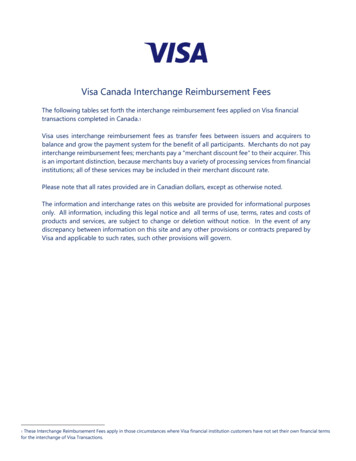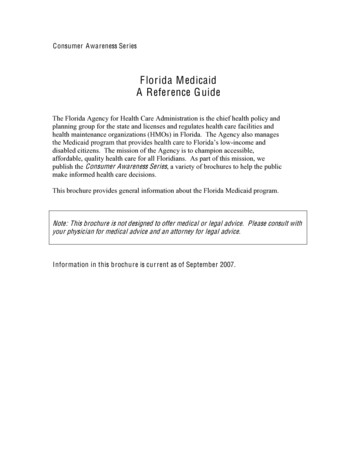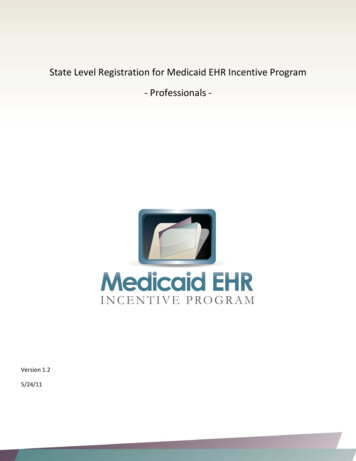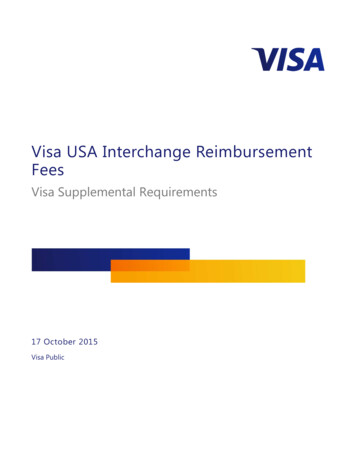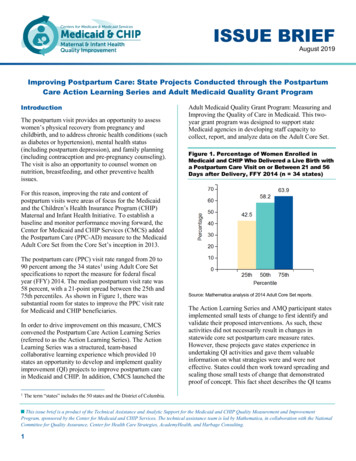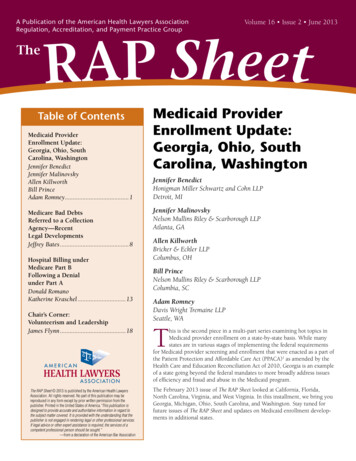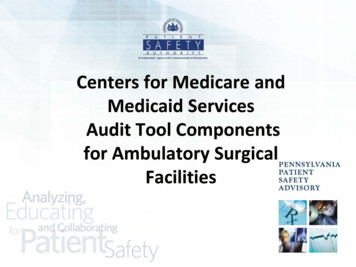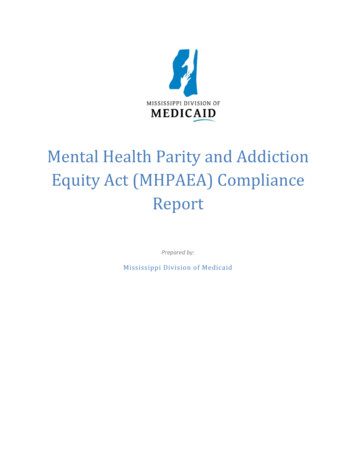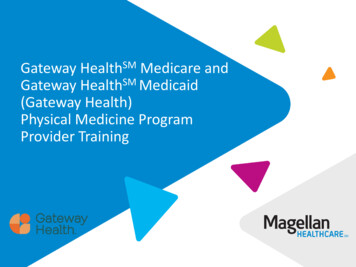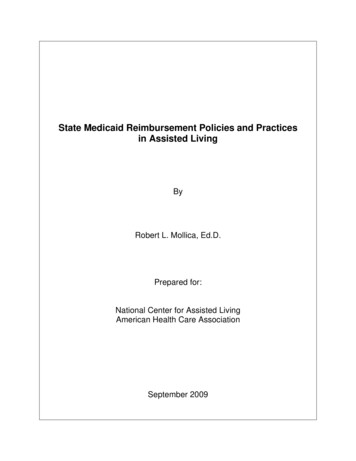
Transcription
State Medicaid Reimbursement Policies and Practicesin Assisted LivingByRobert L. Mollica, Ed.D.Prepared for:National Center for Assisted LivingAmerican Health Care AssociationSeptember 2009
ContentsAcknowledgments. ivExecutive Summary .vMajor Findings.vBackground .1Methodology .2Section 1: Summary of Survey Findings.3Medicaid options for covering services in residential settings .3§1915 (c) waivers.3§1115 demonstration programs.5§1915 (i) HCBS state plan option.6Coverage .6Participation rates.7Rate methodology and payments .9Flat rates.10Tiered rates.10Case mix rates .12Fee-for-service rates.14Rate changes .15Room and board policies .15SSI state supplements .17Family supplementation.17Services .18Unit requirements.19Mental health screening .20Discussion .21CMS regulations .24Section 2: State Summaries.27Alaska .28Arizona.30Arkansas.33California .36Colorado.38Connecticut .40Delaware .42District of Columbia .44Florida .46Georgia.49Hawaii .51Idaho .53Illinois .55Indiana.57i
Iowa .59Kansas .61Louisiana.63Maine .65Maryland .67Massachusetts .70Michigan .72Minnesota.75Mississippi .79Missouri .80Montana .82Nebraska .84Nevada .87New Hampshire .89New Jersey .91New Mexico.93New York.95North Carolina .97North Dakota.99Ohio .101Oklahoma.104Oregon.106Pennsylvania .109Rhode Island .110South Carolina .112South Dakota.113Tennessee.115Texas .117Utah .119Vermont .121Virginia .124Washington .126West Virginia .131Wisconsin.132Wyoming.135Section 3: Results Tables .137Section 4: State and National Statistics on Nursing Homes and ALFs.151Appendix A: CMS Policy Guidance for MFP Grantees.157Appendix B: CMS Waiver Review Guidelines .161ii
Figures and TablesFigure 1: Nursing home and HCBS spending. 2Table 1: Differences between state plan and waiver services. 5Table 2: Sources of coverage reported by responding states. 7Table 3: Participation in Medicaid and state general revenue programs . 8Table 4: State rate methodologies. 15Table 5: Supplementation policy . 17Table 6: Unit requirements . 19Table 7: Furnishing the unit. 20Table 8: Screening for mental illness. 20Table 9: Arranging mental health services . 21Table 10: Coverage . 138Table 11: Rate methodology. 139Table 12: Number of facilities . 141Table 13: Number of participants . 142Table 14: Room and board policy. 144Table 15: Unit requirements . 146Table 16: Mental health screening. 147Table 17: Services included in the rate . 149iii
AcknowledgmentsI would like to acknowledge the many policymakers in state agencies across the country whocompleted the survey and contributed to preparation of this report. I appreciate the willingness ofthese dedicated professionals to share their knowledge and expertise. I also thank Don Redfootof the AARP Public Policy Institute for his thoughtful comments and suggestions.iv
Executive SummaryAssisted living is an important component of the U.S. long-term care system. As statepolicymakers seek cost-effective alternatives to providing services in nursing homes, assistedliving settings provide oversight and access to services that are difficult to schedule for peoplewho live in their own homes. Consumer preferences for options to institutional care and thestates’ interest in reducing Medicaid expenditure growth rates have created a shift in the supplyand utilization of nursing homes over the past several years. This report presents information onstate coverage of services in assisted living/residential settings and includes the source ofcoverage, the number of participating facilities, number of people served, payment rates, andother data.For this report, information was obtained from two primary sources. Baseline information onstate-assisted living reimbursement policies and practices was provided by previous studiessponsored by the U.S. Department of Health and Human Services, Office of the AssistantSecretary for Policy and Evaluation, and RTI International in 2002, 2004, and 2007. Theinformation was updated through an electronic survey and telephone calls with staff responsiblefor managing Medicaid services in licensed assisted living/residential care facility settings.Information was also obtained from state Web sites when available. Responses were receivedfrom 47 states (including the District of Columbia). Three states—Alabama, Kentucky, andPennsylvania—do not cover services in residential settings. Information for states that did notrespond to the survey was obtained from previous reports and material provided on state Websites. Data were collected between March and June of 2009.Major Findings Coverage of services in licensed assisted living settings increased compared toprevious reports. Participants served through home and community-based services(HCBS) and §1115 waivers and state plan services increased 9.2% between 2007and 2009 and 43.7% between 2002 and 2009.Including state general revenue programs, the number of participants increased11% between 2007 and 2009 and 44% between 2002 and 2009.The number of §1915 (c) and §1115 waiver participants rose 122% between 2002and 2009.Thirty-seven states use §1915 (c) HCBS waivers to cover services in residentialsettings; 13 states use the Medicaid state plan services (personal care or otherstate plan service); four include services in residential settings under §1115demonstration program authority; and six use state general revenues. States mayuse more than one funding source.Tiered rates are the most common method for reimbursing assisted livingproviders (19 states), and flat rates are used in 17 states.Forty states do not include room and board paid by the resident in the assistedliving rate.Twenty-three states cap the amount that can be charged for room and board.v
Twenty-four states supplement the federal Supplemental Security Income (SSI)payment. Payment standards range from 722 to 1,350 a month.Twenty-five states permit family members or third parties to supplement roomand board charges.Twenty-three states require apartment-style units, 40 states allow units to beshared, and 24 states allow sharing by choice of the residents.Screening for mental health needs is performed by case managers and assistedliving facility (ALF) staff in nine states, by case managers only in 10 states, andby ALF staff in nine states.Mental health services are arranged by ALFs in 16 states and by case managers in20 states; such services may be provided directly by ALFs in three states.Medicaid waiver coverage of services in licensed assisted living and residential settings maysoon change. The Centers for Medicare & Medicaid Services (CMS) issued an advance notice ofproposed rulemaking in June following its earlier issuance of proposed regulations to implementthe home and community-based services state plan option under which CMS would set criteria todetermine when ALFs can be considered “community settings.” The June notice describes asimilar approach to residential settings covered under §1915 (c) waivers. The planned changeswill “include methods that states may follow to identify financing mechanisms for reducing thesize of existing large residences, divesting themselves or helping their providers divestthemselves of sizeable properties and assisting providers’ transition to small, more individualizedsettings.” The notice further states that “some individuals who receive HCBS in a residentialsetting managed or operated by a service provider have experienced a provider-centered andinstitution-like living arrangement, instead of a person-centered and home-like environment withthe freedoms that should be characteristic of any home and community-based setting.”The process for determining facilities that will be considered community settings could changestate contracting practices, especially in states that do not require apartment-style units, and limitwhich facilities in a state will be able to serve waiver participants.vi
BackgroundAssisted living is an important component of the U.S. long-term care system. State policymakershave been seeking cost-effective alternatives to services in nursing homes. Assisted livingsettings provide oversight and access to services that are difficult to schedule for people who livein their own homes. Consumer preferences for options to institutional care and the states’ interestin reducing Medicaid expenditure growth rates have created a shift in the supply and utilizationof nursing homes over the past several years.The supply of nursing homes declined 1.6% between 2001 and 2008 nationally. Overall, 16states experienced an increase in supply and 34 states saw a decline. Supply dropped the most inWisconsin (17.8%) and Minnesota (15.9%) but increased more than 11% in three states—Delaware, Nevada, and Texas. Although the supply grew in Texas, the occupancy rate inDecember 2008 was 73.7%. Occupancy rates in Delaware and Nevada were 92.5% and 88.3%respectively.1 The number of Medicaid beneficiaries served in nursing homes dropped 8.3%nationally. Medicaid occupancy increased in only three states—Delaware (1.6%), Maryland(3%), and Nevada (5.5%).The gradual trend toward service alternatives is also reflected in the percentage of Medicaidspending for institutional and community services including residential settings. Medicaidspending for nursing home care is considerably greater than spending on personal care and homeand community-based services (HCBS) waivers for older adults and adults with physicaldisabilities. However, spending for personal care and waiver services for these populations rose81.5% between fiscal year (FY) 2001 and FY2007 while nursing home spending increased 9.8%(figure 1).Nursing home spending grew from 42.7 billion in FY2001 to 46.9 billion in FY2007. HCBSspending was 9.2 billion in FY2001 and 16.7 billion in FY2007. The figures do not includespending for adult day health care and other state plan services in some states. Although servicesin residential settings are included in these figures and contribute to spending on HCBS, they arenot reported separately.1American Health Care Association (AHCA) based on Online Survey, Certification and Reporting (OSCAR) data.1
Figure 1: Nursing home and HCBS spending 60Billions 50 40 30 20 10 020012002200320042005Nursing homeHCBS20062007MethodologyInformation presented in this report was obtained from two primary sources. Baselineinformation on state-assisted living reimbursement policies and practices was garnered fromprevious studies by the National Academy for State Health Policy sponsored by the U.S.Department of Health and Human Services, Office of the Assistant Secretary for Policy andEvaluation, and RTI International in 2002, 2004, and 2007. The information was updatedthrough an electronic survey and telephone calls with staff responsible for managing Medicaidservices in licensed assisted living/residential care facility settings. Information was alsoobtained from state Web sites when available. Responses were received from 47 states (includingthe District of Columbia). Information for states that did not respond to the survey was obtainedfrom previous reports and material provided on state Web sites. Data were collected betweenMarch and June 2009. Surveys were not returned by Mississippi, North Dakota, South Dakota, orVirginia. Alabama and Kentucky do not yet cover services in assisted living. Louisiana andOklahoma submitted applications to the Centers for Medicare & Medicaid Services (CMS) tocover services under a §1915 (c) waiver and are included in the report. Pennsylvania plans tocover assisted living when regulations creating a new licensing category are promulgated.The report has four sections: (1) a discussion of the topics reported on the survey; (2) individualstate summaries; (3) tabulated state survey responses; and (4) state and national statistics onnursing homes and assisted living facilities.2
Section 1: Summary of Survey FindingsMedicaid options for covering services in residential settingsStates use three approaches to pay for services in residential care settings under Medicaid:§1915 (c) home and community-based services (HCBS) waivers, the Medicaid personal carestate plan option, and §1115 demonstration programs. States most often use the HCBS waiveroption. Fewer states use the personal care state plan option. Florida, Maine, Massachusetts,South Carolina, and Vermont use nontraditional state plan coverage, that is, services that are notspecifically listed as state plan services under Title XIX.§1915 (c) waiversCongress authorized HCBS waivers in 1981 to serve individuals who meet the state’s criteria foradmission to an institution. HCBS waivers cover services that are not covered by the Medicaidstate plan, such as personal care not covered by the state plan (home delivered meals; adult daycare; personal emergency response systems; respite care; or environmental accessibilityadaptations and other services that are required to prevent, delay, or substitute for admission toan institution).The waiver authority allows states to limit services to specific counties or regions of a state andto target services to certain groups—strategies that are not normally allowed under Medicaid.State Medicaid agencies must ensure that waiver programs have provisions to ensure the healthand welfare of participants. Unlike regular Medicaid state plan services, except for HCBSservices under §1915 (i), waiver programs may have waiting lists.Finally, average expenditures for waiver beneficiaries must be the same or less than they wouldhave been without the waiver (no more than average Medicaid nursing home costs).2 Medicaidcannot cover room and board in residential settings. Medicaid can cover room and board only inan institution, such as a nursing home, an intermediate care facility for persons with mentalretardation (ICFs-MR), or a hospital.The HCBS waiver application template (version 3.5) allows states to list services in assistedliving and other residential settings under “other.”3 The CMS instructions for reviewing waiversdefine assisted living as follows: “An assisted living facility provides residents personal care andother assistance as needed with activities of daily living (ADLs) and instrumental activities ofdaily living (IADLs) but does not provide round-the-clock skilled nursing services. Assistedliving facilities generally provide less intensive care than nursing facilities and emphasizeresident privacy and choice.”2States can use either a fixed per capita amount for each beneficiary or average the expenditures across all waiverbeneficiaries. Aggregate caps provide more flexibility because they allow some beneficiaries to exceed the nursingfacility costs that are offset by lower costs for other participants and the average waiver cost does not exceed theaverage nursing facility cost. States have the option of setting a cap on waiver services at a percentage of nursinghome costs (e.g., 80%).3Available at: https://www.hcbswaivers.net/CMS/faces/portal.jsp.3
The waiver application template also requires that states describe the standards that apply such asthe services provided and how “a home and community character is maintained in thesesettings.” Standards have to address admission policies, physical environment, sanitation, safety,staff/resident ratios, staff training and supervision, staff supervision, resident rights, medicaladministration, use of restrictive interventions, incident reporting, and provisions of orarrangement for necessary health services. Criteria for standards that meet “home andcommunity character” are not described. The application must also include a description of themethodology states use to exclude Medicaid payment for room and board costs.See appendix B for the guidelines related to assisted living that are used by CMS staff to reviewwaiver applications.HCBS waivers and state plan services differ in several important ways. First, waiver services areavailable only to beneficiaries who meet the state’s nursing home level of care criteria; that is,they would be eligible for Medicaid payments in a nursing home if they applied for admission.Nursing home eligibility is not required for beneficiaries using state plan services.Second, states may set limits on the number of beneficiaries that can be served through waiverprograms. The limits are defined as expenditure caps that are part of the cost neutrality formularequired for CMS approval. Waivers are only approved if the state demonstrates that Medicaidexpenditures under the waiver will not exceed expenditures that would have been made in theabsence of the waiver. States do not receive federal reimbursements for waiver expenditures thatexceed the amount stated in the cost neutrality calculation. In contrast, state plan services are anentitlement, meaning that all beneficiaries who meet the eligibility criteria must be served.Federal reimbursement is available for all state plan expenditures without any cap.Perhaps the most significant difference between the two options is the ability under HCBSwaivers to use more generous income eligibility standards. To be eligible for personal care underthe state plan, individuals must meet Medicaid’s community-based eligibility standards, which(depending on the state) are the Supplemental Security Income (SSI) level of income ( 674 permonth in 2009), the state SSI supplement payment standard, if any, an amount above the SSIstandard up to 100% of the federal poverty level, or the state’s medically needy incomestandard.4For nursing home and HCBS waiver applicants, states may use the special income level, which isan optional eligibility category that allows individuals with income up to 300% of the federal SSIbenefit ( 2,022 a month in 2009) to be eligible. However, states can only cover this optionthrough HCBS waivers if they also cover it in a nursing home. Offering the higher incomeeligibility standard in the waiver program levels the playing field between institutional andnoninstitutional services. See table 1 for a comparison of the major differences between waiverservices and state plan services.Although the majority of states cover services in residential care settings through Medicaid, thenumber of Medicaid beneficiaries who receive such services is considerably lower than might be4Except in 209(b) states, which have a Medicaid income or resource eligibility threshold that is lower than thefederal SSI
Assisted living is an important component of the U.S. long-term care system. As state policymakers seek cost-effective alternatives to providing services in nursing homes, assisted living settings provide oversight and access to services that are diff

